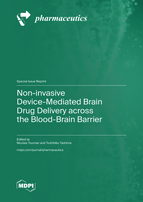Non-invasive Device-Mediated Brain Drug Delivery across the Blood-Brain Barrier
A special issue of Pharmaceutics (ISSN 1999-4923). This special issue belongs to the section "Drug Delivery and Controlled Release".
Deadline for manuscript submissions: closed (20 December 2023) | Viewed by 22694
Special Issue Editors
Interests: blood-brain barrier; organic anion transporters; breast cancer resistance protein; vanadate-sensitive ATPase; multiple drug resistance
Special Issues, Collections and Topics in MDPI journals
Interests: drug design; drug discovery; pharmacophore; drug delivery; organic synthesis; drug cell-membrane permeability; pharmaceutical sciences; medicinal chemistry; chemical biology
Special Issues, Collections and Topics in MDPI journals
Special Issue Information
Dear Colleagues,
We will be serving as the Guest Editor for this very interesting Special Issue on “Non-Invasive Device-Mediated Brain Drug Delivery Across the Blood–Brain Barrier”. It is well-known that the blood–brain barrier (BBB), substantially composed of tight junctions between the capillary endothelial cells and efflux transporters such as MDR1 at the apical membrane of the capillary endothelial cells, prevents drugs from entering the brain. Accordingly, drug delivery into the brain across the BBB is a challenging task, particularly in central nervous system diseases such as Alzheimer’s disease and Parkinson’s disease as well as brain cancers such as glioma. It is true that drugs in systemic circulation go through intentional membrane disruption or intentional tight junction disruption into the brain across the BBB, but bystander harmful compounds can enter the brain together. Moreover, although craniotomy is often conducted for surgical removal or direct drug administration, this process burdens and torments patients. Thus, non-invasive, device-mediated brain drug delivery across the BBB should be developed to improve not only patient health, but also quality of life. At present, brain drug delivery systems that utilize biological transport machineries such as carrier-mediated transport, receptor-mediated transcytosis, lipid-raft-mediated transcytosis, or macropinocytosis at the BBB have been extensively investigated. This Special Issue aims to share recent progress and trends in this field. We welcome submissions of all types of original articles concerned with noninvasive drug delivery into the brain across the BBB.
Topics include, but are not limited to, the strategies outlined below:
˗ Carrier-mediated transport
- Drugs containing transporter recognition unit;
- Substrate–drug conjugates with cleavable linkers.
˗ Receptor-mediated transcytosis
- Antibody-drug conjugates with cleavable or uncleavable linkers;
- Bispecific antibodies as antibody drugs;
- Ligand-drug conjugates using ligands such as cell-penetrating peptides or homing peptides;
- Drug-encapsulated nanoparticles covered with ligands using nanodelivery systems.
˗ Other strategies
Dr. Nicolas Tournier
Dr. Toshihiko Tashima
Guest Editors
Manuscript Submission Information
Manuscripts should be submitted online at www.mdpi.com by registering and logging in to this website. Once you are registered, click here to go to the submission form. Manuscripts can be submitted until the deadline. All submissions that pass pre-check are peer-reviewed. Accepted papers will be published continuously in the journal (as soon as accepted) and will be listed together on the special issue website. Research articles, review articles as well as short communications are invited. For planned papers, a title and short abstract (about 100 words) can be sent to the Editorial Office for announcement on this website.
Submitted manuscripts should not have been published previously, nor be under consideration for publication elsewhere (except conference proceedings papers). All manuscripts are thoroughly refereed through a single-blind peer-review process. A guide for authors and other relevant information for submission of manuscripts is available on the Instructions for Authors page. Pharmaceutics is an international peer-reviewed open access monthly journal published by MDPI.
Please visit the Instructions for Authors page before submitting a manuscript. The Article Processing Charge (APC) for publication in this open access journal is 2900 CHF (Swiss Francs). Submitted papers should be well formatted and use good English. Authors may use MDPI's English editing service prior to publication or during author revisions.
Keywords
- drug delivery systems
- the blood-brain barrier (BBB)
- non-invasive brain drug delivery
- nanodelivery systems
- transporter-consciously designed drug
- carrier-mediated transport
- receptor-mediated transcytosis
- central nervous system disease
- Alzheimer's disease (AD)
- Parkinson's disease (PD)
- brain cancer







